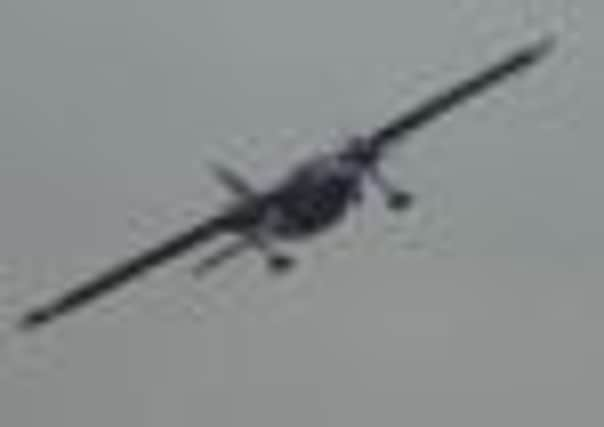PSNI plane crashed after 12th rioting


Three people were on board when the police spy plane touched down on the grass over 100 metres short of the Aldergrove runway threshold colliding with the approach lighting system at approximately 2am on Wednesday, July 13.
The BN2T Islander (G-BSWR) - one of only two such planes officially used by police forces in the entire UK - was coming back from a 2.5 hour “operation in an area to the northwest of the airport.”
Advertisement
Hide AdAdvertisement
Hide AdThe accident occurred on a night of rioting in Londonderry which followed the Twelfth celebrations. Twelve people, including one woman, were arrested after petrol bombs and bricks were thrown at police. There was trouble in the Bogside and Gobnascale areas of the city.
Neither the 46-year-old pilot, who had 5,740 hours (of which 2,212 were on type) flying experience, or the two passengers were hurt.
But damage was sustained to a propeller blade on the right engine, the nose cone and the fuselage. The officers on board thought they might have hit a hare on the runway when coming in to land.
According to an accident report the weather on the night was clear and cloudless when the plane returned from its second operation of the night.
Advertisement
Hide AdAdvertisement
Hide Ad“The pilot’s perception was that the approach was normal and that he flared and carried out an uneventful landing. However, after touchdown he and his two passengers heard a number of dull thuds,” the report reveals.
After taxiing to Aldergrove’s parking area and shutting down the engines on the 22-year-old aircraft “the pilot and passengers discussed the thuds they had heard and, initially, thought that they may have been caused by contact with a hare or other animal during the landing.”
A survey of the outside of the plane, however, revealed grass on the underside and damage to the starboard side of the fuselage.
The pilot phoned Air Traffic Control (ATC) to advise them that he may have made contact with the approach lights.
Advertisement
Hide AdAdvertisement
Hide Ad“A runway inspection vehicle was detailed to inspect the lighting system and reported damage to the last three centreline approach lights.
“A further inspection showed tyre marks in the grass starting 80 metres short of the paved surface, 125 metres short of the displaced runway threshold,” the report explains.
According to the official accident report the plane was in pretty bad shape after the crash.
“The damage to the aircraft was significant. The starboard propeller was damaged, the engine required inspection for possible shock loading, there was impact damage to the nose cone and scratching, denting and a puncture hole in the starboard fuselage. There were also several other holes in the aircraft’s skin,” it states.
Advertisement
Hide AdAdvertisement
Hide AdThe accident occurred despite the pilot’s extensive experience and the fact that in the three months prior to the accident the Islander had been in the air on operations for 64 hours solid. In the 28 days prior to the accident it had been in the air for over a whole day collectively.
Equally, the pilot felt “the approach and landing were normal” and was “unaware that there had been anything unusual with the landing until after shutting the engines down.”
The pilot subsequently felt the merging of runway lights may have contributed to the accident.
“Other possible factors were that the night was very dark, with high overcast cloud, and that the final approach for Runway 07 is over an area with little cultural lighting.
Advertisement
Hide AdAdvertisement
Hide Ad“There was, therefore, a lack of visual cues, other than the Precision approach path Indicator (PAPI) on which to judge the position of the aircraft relative to the surface and the runway.
“The operator has advised its pilots that the PAPIs must be used for approaches at night when they are available,” the report says.
The accident - details of which are disclosed for the first time in today’s Sentinel - occurred less than a year after four people were injured when a police helicopter overturned in the Mourne mountains.
According to the PSNI its Air Support Unit (ASU) assists front line officers throughout Northern Ireland with crime investigations, anti-crime operations, traffic management, search and rescue, public order situations, crime reduction initiatives and tackling terrorism.
Advertisement
Hide AdAdvertisement
Hide AdFor example, the PSNI drafted in air support for last year’s Vital festival in Bangor - played by Londonderry group The Wonder Villains and US rapper Eminem - costing £9,625 in total.
The PSNI has more aircraft than any other police service in the UK - including the Metropolitan and the Greater Manchester forces.
The damaged Islander was one of just two out of 35 official police aircraft throughout the UK. Another Islander operates from Manchester.
The Sentinel asked the PSNI if the plane crashed after providing air support during the dissident republican rioting in Londonderry last year.
The paper also asked how much it cost to repair the damage.
A spokesperson said the paper should contact the PSNI’s Freedom of Information (FOI) department for this information.